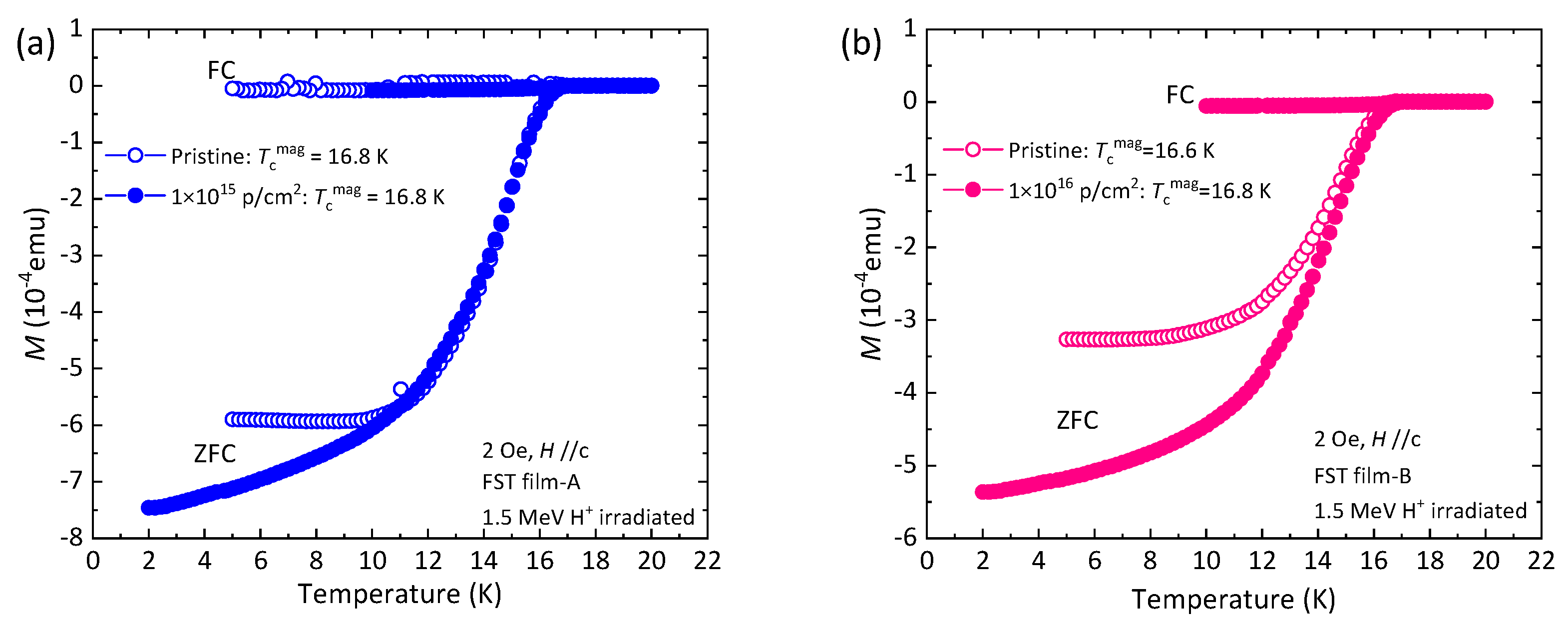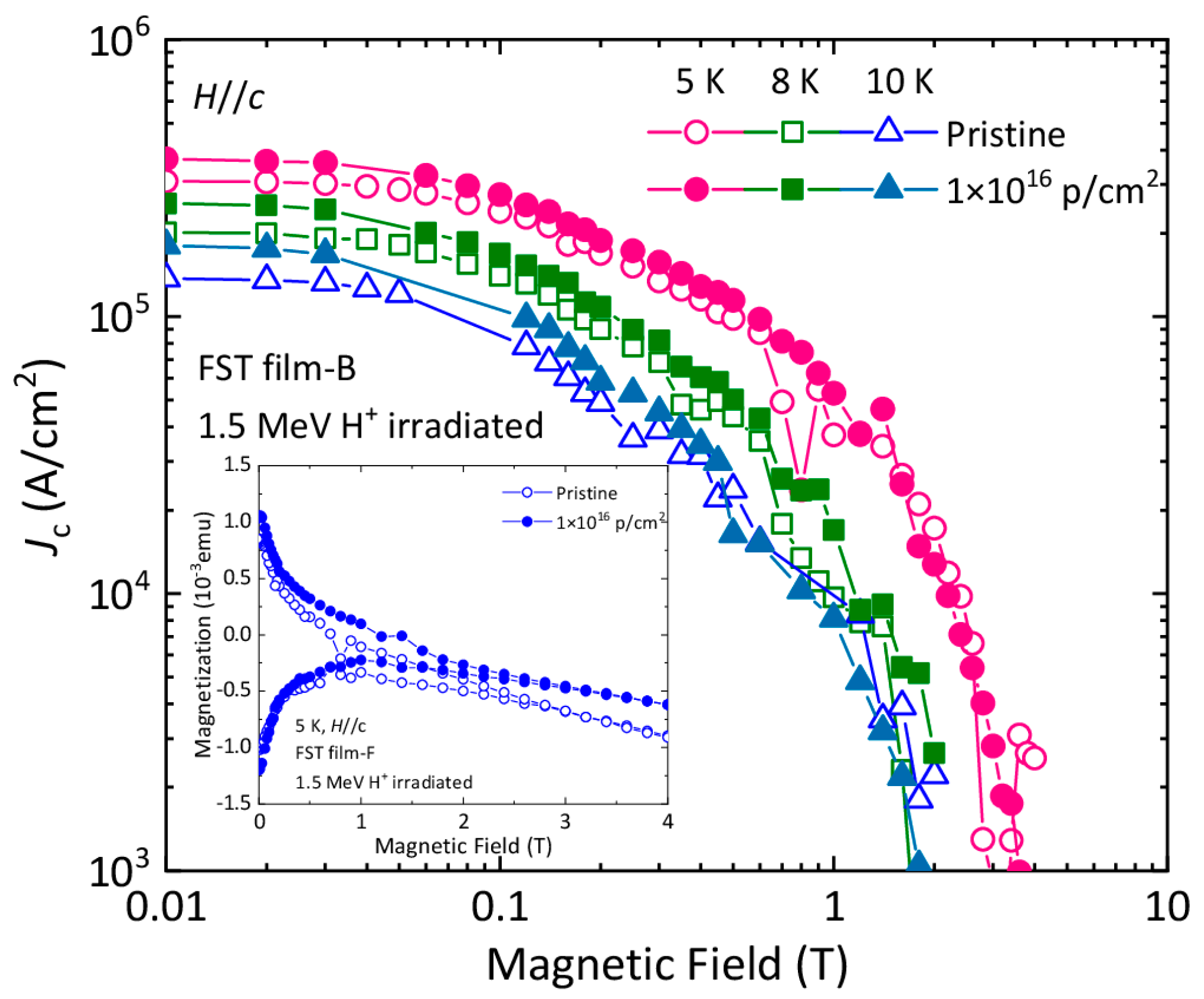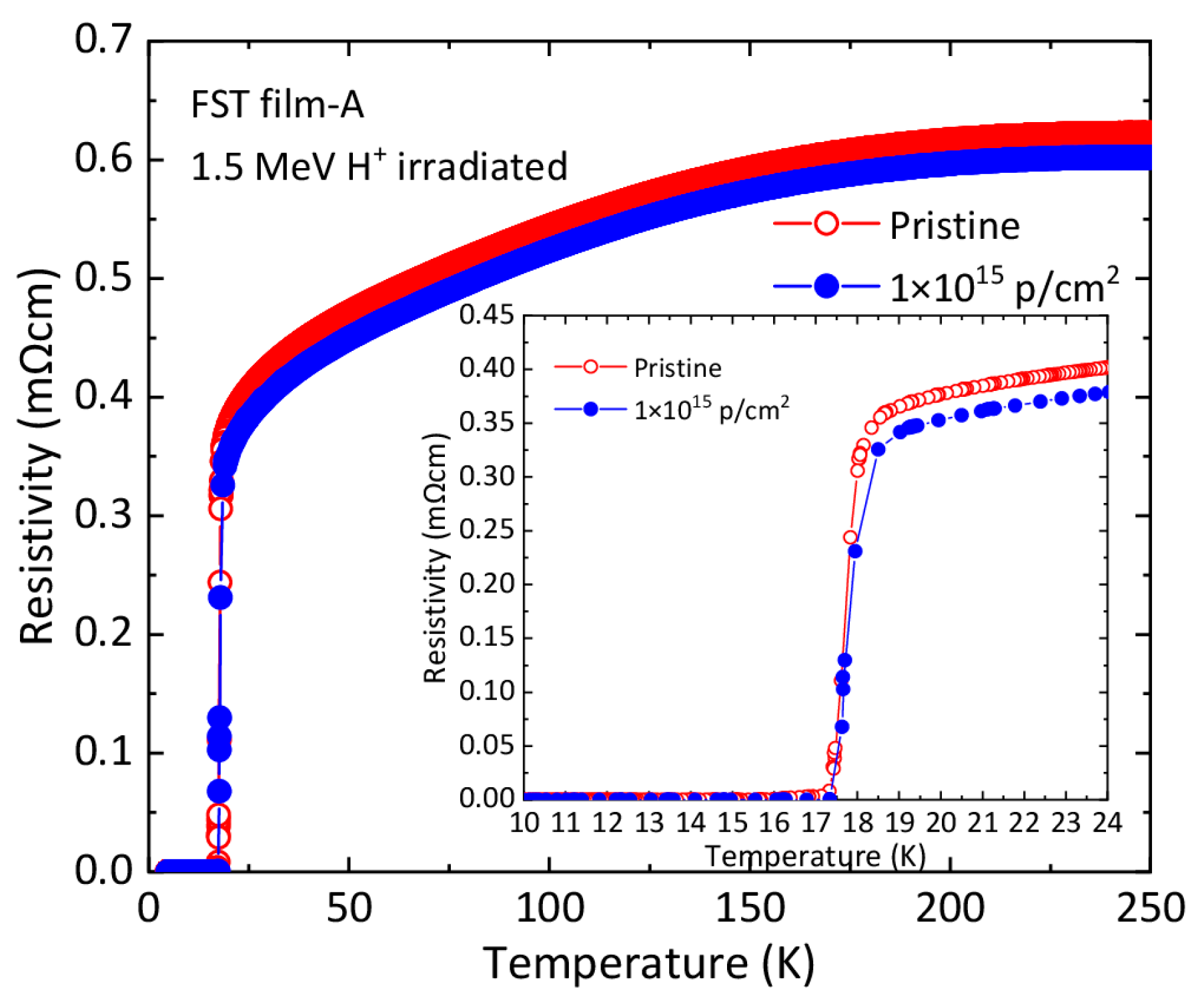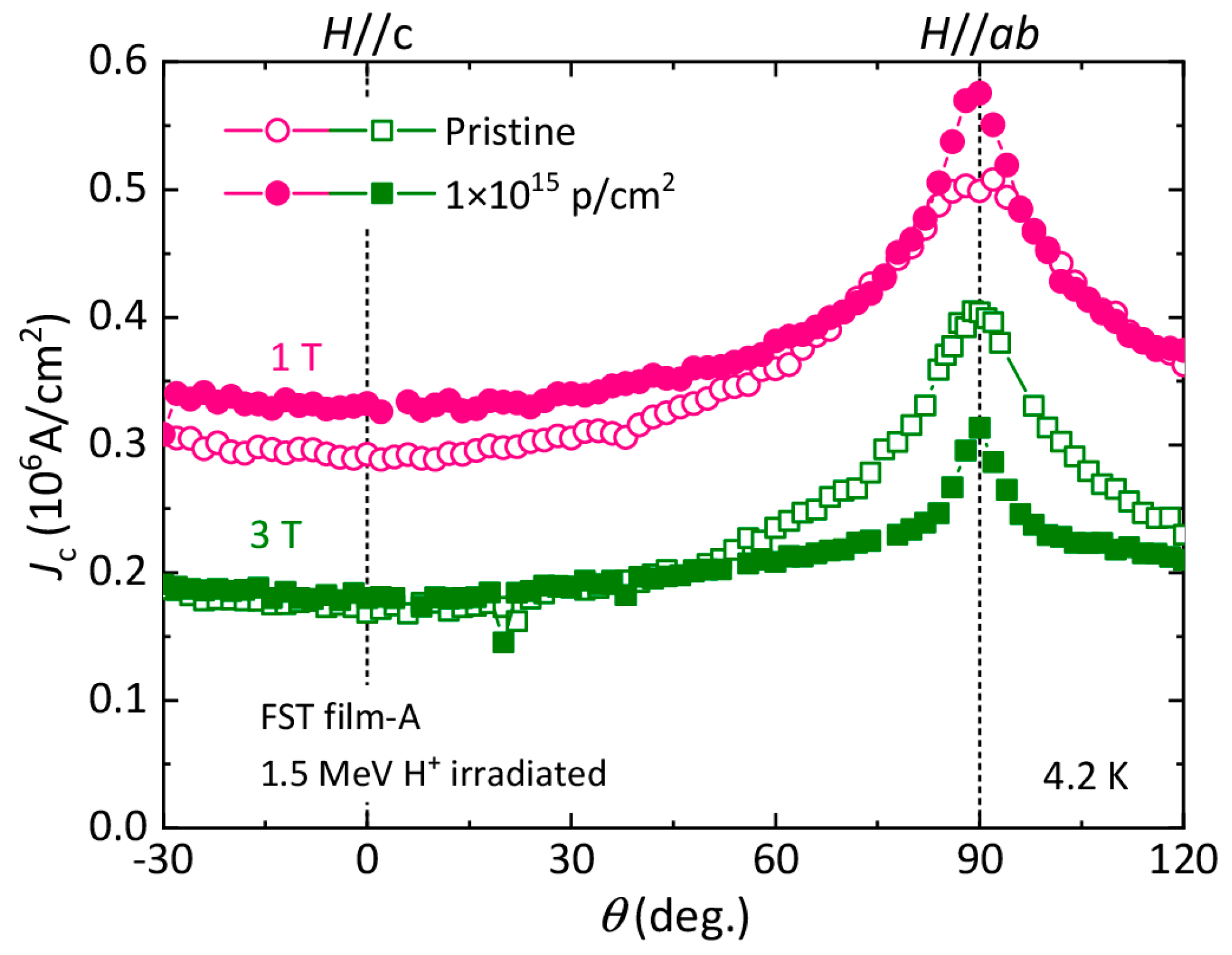Effect of 1.5 MeV Proton Irradiation on Superconductivity in FeSe0.5Te0.5 Thin Films
Abstract
1. Introduction
2. Materials and Methods
3. Results and Discussion
3.1. Magnetic Measurements
3.2. Transport Measurement
4. Conclusions
Author Contributions
Funding
Acknowledgments
Conflicts of Interest
References
- Putti, M.; Pallecchi, I.; Bellingeri, E.; Cimberle, M.R.; Tropeano, M.; Ferdeghini, C.; Palenzona, A.; Tarantini, C.; Yamamoto, A.; Jiang, J.; et al. New Fe-based superconductors: Properties relevant for applications. Supercond. Sci. Technol. 2010, 23, 034003. [Google Scholar] [CrossRef]
- Gurevich, A. Iron-based superconductors at high magnetic fields. Rep. Prog. Phys. 2011, 74, 124501. [Google Scholar] [CrossRef]
- Katase, T.; Ishimaru, Y.; Tsukamoto, A.; Hiramatsu, H.; Kamiya, T.; Tanabe, K.; Hosono, H. Advantageous grain boundaries in iron pnictide superconductors. Nat. Commun. 2011, 2, 409. [Google Scholar] [CrossRef] [PubMed]
- Si, W.; Zhang, C.; Shi, X.; Ozaki, T.; Jaroszynski, J.; Li, Q. Grain boundary junctions of FeSe0.5Te0.5 thin films on SrTiO3 bi-crystal substrates. Appl. Phys. Lett. 2015, 106, 032602. [Google Scholar] [CrossRef]
- Iida, K.; Hänisch, J.; Yamamoto, A. Grain boundary characteristics of Fe-based superconductors. Supercond. Sci. Technol. 2020, 33, 043001. [Google Scholar] [CrossRef]
- Larbalestier, D.; Gurevich, A.; Feldmann, D.M.; Polyanskii, A. High-Tc superconducting materials for electric power applications. Nature 2001, 414, 368. [Google Scholar] [CrossRef] [PubMed]
- Foltyn, S.R.; Civale, L.; MacManus-Driscoll, J.L.; Jia, Q.X.; Maiorov, B.; Wang, H.; Maley, M. Materials science challenges for high-temperature superconducting wire. Nat. Mater. 2007, 6, 631. [Google Scholar] [CrossRef] [PubMed]
- Kirk, M.A. Structure and flux pinning properties of irradiation defects in YBa2Cu3O7−x. Cryogenics 1993, 33, 235. [Google Scholar] [CrossRef]
- Matsui, H.; Ogiso, H.; Yamasaki, H.; Kumagai, T.; Sohma, M.; Yamaguchi, I.; Manabe, T. 4-fold enhancement in the critical current density of YBa2Cu3O7 films by practical ion irradiation. Appl. Phys. Lett. 2012, 101, 232601. [Google Scholar] [CrossRef]
- Jia, Y.; LeRoux, M.; Miller, D.J.; Wen, J.G.; Kwok, W.K.; Welp, U.; Rupich, M.W.; Li, X.; Sathyamurthy, S.; Fleshler, S.; et al. Doubling the critical current density of high temperature superconducting coated conductors through proton irradiation. Appl. Phys. Lett. 2013, 103, 122601. [Google Scholar] [CrossRef]
- Ozaki, T.; Wu, L.; Zhang, C.; Si, W.; Jie, Q.; Li, Q. Enhanced critical current in superconducting FeSe0.5Te0.5 films at all magnetic field orientations by scalable gold ion irradiation. Supercond. Sci. Technol. 2018, 31, 024002. [Google Scholar]
- Zhang, Y.; Rupich, M.W.; Solovyov, V.; Li, Q.; Goyal, A. Dynamic behavior of reversible oxygen migration in irradiated-annealed high temperature superconducting wires. Sci. Rep. 2020, 10, 14848. [Google Scholar] [CrossRef]
- Sueyoshi, T.; Kotaki, T.; Furuki, Y.; Fujiyoshi, T.; Semboshi, S.; Ozaki, T.; Sakane, H.; Kudo, M.; Yasuda, K.; Ishikawa, N. Strong flux pinning by columnar defects with directionally dependent morphologies in GdBCO-coated conductors irradiated with 80 MeV Xe ions. Jpn. J. Appl. Phys. 2020, 59, 023001. [Google Scholar] [CrossRef]
- Civale, L. Vortex pinning and creep in high-temperature superconductors with columnar defects. Supercond. Sci. Technol. 1997, 10, A11. [Google Scholar] [CrossRef]
- Kirk, M.A.; Yan, Y. Structure and properties of irradiation defects in YBa2Cu3O7−x. Micron 1999, 30, 507. [Google Scholar] [CrossRef]
- Ozaki, T.; Wu, L.; Zhang, C.; Jaroszynski, J.; Si, W.; Zhou, J.; Zhu, Y.; Li, Q. A route for a strong increase of critical current in nanostrained iron-based superconductors. Nat. Commun. 2016, 7, 13036. [Google Scholar] [CrossRef] [PubMed]
- Ozaki, T.; Wu, L.; Gu, G.; Li, Q. Ion irradiation of iron chalcogenide superconducting films. Supercond. Sci. Technol. 2020, 33, 094008. [Google Scholar] [CrossRef]
- Ziegler, J.F.; Biersack, J.P.; Littmark, U. The Stopping and Range of Ions in Solids; Pergamon: Oxford, UK, 1985. [Google Scholar]
- Eisterer, M. Radiation effects on iron-based superconductors. Supercond. Sci. Technol. 2018, 31, 013001. [Google Scholar] [CrossRef]
- Teknowijoyo, S.; Cho, K.; Tanatar, M.A.; Gonzales, J.; Böhmer, A.E.; Cavani, O.; Mishra, V.; Hirschfeld, P.J.; Bud’ko, S.L.; Canfield, P.C.; et al. Enhancement of superconducting transition temperature by pointlike disorder and anisotropic energy gap in FeSe single crystals. Phys. Rev. B 2016, 94, 064521. [Google Scholar] [CrossRef]
- Mizukami, Y.; Konczykowski, M.; Matsuura, K.; Watashige, T.; Kasahara, S.; Matsuda, Y.; Shibauchi, T. Impact of Disorder on the Superconducting Phase Diagram in BaFe2(As1−xPx)2. J. Phys. Soc. Jpn. 2017, 86, 083706. [Google Scholar] [CrossRef]
- Sylva, G.; Bellingeri, E.; Ferdeghini, C.; Martinelli, A.; Pallecchi, I.; Pellegrino, L.; Putti, M.; Ghigo, G.; Gozzelino, L.; Torsello, D.; et al. Effects of high-energy proton irradiation on the superconducting properties of Fe(Se, Te) thin films. Supercond. Sci. Technol. 2018, 31, 054001. [Google Scholar] [CrossRef]
- Leo, A.; Sylva, G.; Braccini, V.; Bellingeri, E.; Martinelli, A.; Pallecchi, I.; Ferdeghini, C.; Pellegrino, L.; Putti, M.; Ghigo, G.; et al. Anisotropic Effect of Proton Irradiation on Pinning Properties of Fe(Se, Te) Thin Films. IEEE Trans. Appl. Supercond. 2019, 21, 6601904. [Google Scholar] [CrossRef]
- Leo, A.; Grimaldi, G.; Nigro, A.; Ghigo, G.; Gozzelino, L.; Torsello, D.; Braccini, V.; Sylva, G.; Ferdeghini, C.; Putti, M. Critical current anisotropy in Fe(Se, Te) films irradiated by 3.5 MeV protons. J. Phys. Conf. Ser. 2020, 1559, 012042. [Google Scholar] [CrossRef]
- Bean, C.P. Magnetization of Hard Superconductors. Phys. Rev. Lett. 1962, 8, 250. [Google Scholar] [CrossRef]
- Bean, C.P. Magnetization of High-Field Superconductors. Rev. Mod. Phys. 1964, 36, 31. [Google Scholar] [CrossRef]
- Haberkorn, N.; Maiorov, B.; Usov, I.O.; Weigand, M.; Hirata, W.; Miyasaka, S.; Tajima, S.; Chikumoto, N.; Tanabe, K.; Civale, L. Influence of random point defects introduced by proton irradiation on critical current density and vortex dynamics of Ba(Fe0.925Co0.075)2As2 single crystals. Phys. Rev. B 2012, 82, 180520. [Google Scholar]
- Civale, L.; Maiorov, B.; Serquis, A.; Willis, J.O.; Coulter, J.Y.; Wang, H.; Jia, Q.X.; Arendt, P.N.; MacManus-Driscoll, J.L.; Maley, M.P.; et al. Angular-dependent vortex pinning mechanisms in YBa2Cu3O7 coated conductors and thin films. Appl. Phys. Lett. 2004, 84, 2121. [Google Scholar] [CrossRef]
- Iida, K.; Hänisch, J.; Schulze, M.; Aswartham, S.; Wurmehl, S.; Bűchner, B.; Schultz, L.; Holzapfel, B. Generic Fe buffer layers for Fe-based superconductors: Epitaxial FeSe1-xTex thin films. Appl. Phys. Lett. 2011, 99, 202503. [Google Scholar] [CrossRef]
- Yuan, P.; Xu, Z.; Ma, Y.; Sun, Y.; Tamegai, T. Angular-dependent vortex pinning mechanism and magneto-optical characterizations of FeSe0.5Te0.5 thin films grown on CaF2 substrates. Supercond. Sci. Technol. 2016, 29, 035013. [Google Scholar] [CrossRef]
- Braccini, V.; Kawale, S.; Reich, E.; Bellingeri, E.; Pellegrino, L.; Sala, A.; Putti, M.; Higashikawa, K.; Kiss, T.; Holzapfel, B.; et al. Highly effective and isotropic pinning in epitaxial Fe(Se, Te) thin films grown on CaF2 substrates. Appl. Phys. Lett. 2013, 103, 172601. [Google Scholar] [CrossRef]
- Spechta, E.D.; Goyal, A.; Li, J.; Martin, P.M.; Li, X.; Rupich, M.W. Stacking faults in YBa2Cu3O7-x: Measurement using x-ray diffraction and effects on critical current. Appl. Phys. Lett. 2006, 89, 162510. [Google Scholar] [CrossRef]
- Civale, L.; Maiorov, B.; MacManus-Driscoll, J.L.; Wang, H.; Holesinger, T.G.; Foltyn, S.R.; Serquis, A.; Arendt, P.N. Identification of Intrinsic ab-Plane Pinning in YBa2Cu3O7 Thin Films and Coated Conductors. IEEE Trans. Appl. Supercond. 2005, 15, 2808. [Google Scholar] [CrossRef]
- Iida, K.; Hänisch, J.; Reich, E.; Kurth, F.; Hühne, R.; Schultz, L.; Holzapfel, B. Intrinsic pinning and the critical current scaling of clean epitaxial Fe(Se, Te) thin films. Phys. Rev. B 2013, 87, 104510. [Google Scholar] [CrossRef]
- Grimaldi, G.; Leo, A.; Nigro, A.; Pace, S.; Braccini, V.; Bellingeri, E.; Ferdeghini, C. Angular dependence of vortex instability in a layered superconductor: The case study of Fe(Se, Te) material. Sci. Rep. 2018, 8, 4150. [Google Scholar] [CrossRef] [PubMed]





Publisher’s Note: MDPI stays neutral with regard to jurisdictional claims in published maps and institutional affiliations. |
© 2021 by the authors. Licensee MDPI, Basel, Switzerland. This article is an open access article distributed under the terms and conditions of the Creative Commons Attribution (CC BY) license (https://creativecommons.org/licenses/by/4.0/).
Share and Cite
Ozaki, T.; Kashihara, T.; Kakeya, I.; Ishigami, R. Effect of 1.5 MeV Proton Irradiation on Superconductivity in FeSe0.5Te0.5 Thin Films. Quantum Beam Sci. 2021, 5, 18. https://doi.org/10.3390/qubs5020018
Ozaki T, Kashihara T, Kakeya I, Ishigami R. Effect of 1.5 MeV Proton Irradiation on Superconductivity in FeSe0.5Te0.5 Thin Films. Quantum Beam Science. 2021; 5(2):18. https://doi.org/10.3390/qubs5020018
Chicago/Turabian StyleOzaki, Toshinori, Takuya Kashihara, Itsuhiro Kakeya, and Ryoya Ishigami. 2021. "Effect of 1.5 MeV Proton Irradiation on Superconductivity in FeSe0.5Te0.5 Thin Films" Quantum Beam Science 5, no. 2: 18. https://doi.org/10.3390/qubs5020018
APA StyleOzaki, T., Kashihara, T., Kakeya, I., & Ishigami, R. (2021). Effect of 1.5 MeV Proton Irradiation on Superconductivity in FeSe0.5Te0.5 Thin Films. Quantum Beam Science, 5(2), 18. https://doi.org/10.3390/qubs5020018





